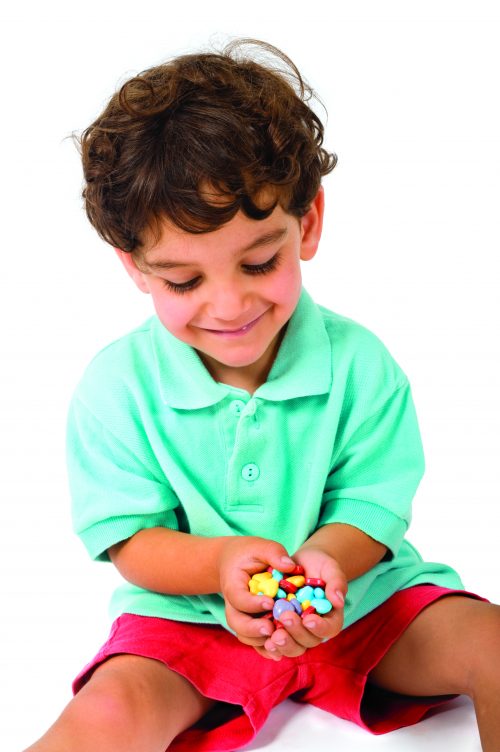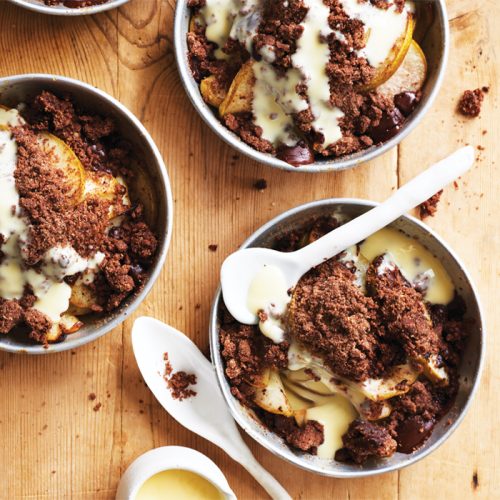
Many not-so-healthy foods are now masquerading as good snack options for kids. Nutritionist Zoe Wilson shows you how to spot the frauds.
You’re standing in the yoghurt aisle in the supermarket with the kids, just about to grab a tub when a little voice pipes up from beside you — 'but I want the one with Dora the Explorer, Mum!' While it may look good to your children, is it actually healthy? And if you say no, how do you avoid the fight and tears that come when you take the Dora box out of the little hands and pick up another yoghurt?
The marketing of 'kids’ foods' not only works at selling a particular brand but is linked to children eating more ‘junk’ food in general, according to research by the Sydney School of Public Health’s Physical Activity, Nutrition and Obesity Research Group.
Even the World Health Organisation has warned marketing poor-quality foods to children is a probable cause of weight gain. This is a major concern, given nearly a third of our kids are overweight.
Advertising lecturer Jane Caro says there is a reason why kids advertising plays on ‘pester power’.
“Children until around the age of 12 or 13 generally don’t have money of their own so they’re targeted as an influencer,” she says.
And the digital age has brought a whole new realm of marketing opportunities, through fun apps kids can play with on their phone or iPad. When an unhealthy product is pushed at kids, however, we need to complain to the manufacturer, says Caro.
“Marketers will market what they’re given. We need to look at what’s in the food. Give a marketer a healthy product and they will market it.”
So what can you, as parents, do to counteract the pull of clever marketing and give your kids the healthiest start in life?
The new world of digital marketing
The new frontier for kids’ food marketing is in smartphone apps. Brands are producing engaging kids’ games that are making it extremely difficult for parents to stay strong against pester power.
Children of all ages have access to multiple forms of social and digital media, making them an easy target for the marketers of unhealthy food. It’s a constant challenge, even for the most vigilant of parents, to oversee what their child is accessing online.
Chupa Chups ‘Lol-a-Coaster’ app is a game where the main character has a lollipop fixed to his mouth and branding is prevalent. It also offered a prize world trip for entering codes found on Chupa Chups lollipops.
Fanta ‘Fruit Slam’ is a heavily branded game in which players ‘power up’ for throwing fruit at each other by drinking bottles of Fanta.
Social media’s positive impact
It’s comforting to know the court of public opinion is now holding manufacturers to account. According to Caro, the rise of social media means marketers are avoiding targeting kids in any untoward way, fearing the possible online backlash.
“They’re being held accountable instantly. Social media is a very effective and instant checker of what the market feels is appropriate and what isn’t,” she says.
Meanwhile, rather than trusting the claims written on the front of the pack, your best guide to a product’s health value is to always look at the ingredients list (see What to look for on the ingredients list, below).
Beware the ‘red sneakers’!
Sugary, high-fat snacks, once considered occasional foods, are now regularly sneaking into school lunches, largely thanks to clever marketing.
Based on a food spectrum where green is an everyday food, amber means select carefully and red is an occasional food, these snack foods have been dubbed ‘red sneakers’.
Red sneakers are occasional foods that are sneaking into the lunchbox every day instead of perhaps once a week. Here are some common offenders:
- Fruit juice snacks such as Nice & Natural Fruit Charms, Bluebird Real Fruit Bars and Florida’s Natural Fruit Nuggets. These come with health halo claims such as ‘65% fruit juice’, ‘no artificial colours or flavours’, ‘99% fat free’ and ‘gluten free’. These give your child the sugar, but not the vitamins, minerals and fibre of fruit. They also get stuck to kids’ teeth which can cause cavities.
- Nutella snack packs. Even though they contain no added colours and preservatives, the first two ingredients in Nutella are sugar and vegetable oil. When added to the lunchbox in snack-pack form, it is similar to giving them a chocolate bar.
- Yoghurt-covered dried fruit or hard yoghurt balls. This hard yoghurt is high in saturated fat and sugar. Kids are better off with fresh fruit, or a small amount of plain dried fruit such as dried apricots or sultanas, instead.
- The Natural Confectionary Co. Just because these lollies have the word ‘natural’ in their name and the claims ‘no artificial colours, no artificial flavours, 99% fat free’ doesn’t mean they are lower in sugar than any other lollies. And whether natural or not, they don’t provide any other vitamins, minerals, protein or fibre.
- Muesli bars with yoghurt or chocolate toppings. Some of these claim to have ‘20 per cent of your daily whole-grain target’, yet what they don’t shout about is the fact that these toppings are high in saturated fat and sugar, so they aren’t the healthiest choice.
What to look for on the ingredients list
INGREDIENTS: Cereals (66%) (rice, rolled barley, wheat, oats [7%], puffed triticale), sugar, wheat gluten, honey (5%), wheat flour, minerals (calcium carbonate, iron, zinc oxide), salt, molasses, flavours, barley malt extract, vitamins (niacin, vitamin B6, riboflavin, thiamine, folate). CONTAINS GLUTEN-CONTAINING CEREALS. MAY CONTAIN TRACES OF PEANUTS AND/OR TREE NUTS.
- The length: The longer the list, the more processed the food and generally, the worse a choice.
- The first three ingredients: If sugar, fat or salt are in the first three ingredients, it’s probably not a great choice. Ingredients are listed in order of the amount that’s in the food. For example, bread will have flour as number one on the ingredient list or muesli will have oats. Also, have a look at the last three ingredients, this is where you’re likely to find additives such as preservatives, colours and flavours.
- Lolly-like ingredients: Stay away from foods which feature hard yoghurt, chocolate, sugar sprinkles or marshmallow in the ingredients list (think yoghurt-coated muesli bars or chocolate-drizzled biscuits). These will be higher in energy and saturated fat.
- Opt for whole grains, seeds, nuts or dried fruit: These will give your child more healthy fibre.
- Go for milk, cheese or yoghurt, which provide protein to help fill kids up, and have more of the vitamins and minerals children need to grow.
The nutrition information panel is the most detailed guide to the proportion of ingredients you will get in a serve, and allows you to recognise if a food is too high in unhealthy ingredients and too low in important nutrients.
Five misleading claims
Like a magic trick, some claims made on foods about certain ‘good’ aspects of the food can cleverly draw our attention away from some of the less healthy content. Some of the most common ‘health halo’ claims to keep an eye out for are:
- ‘No added sugar’ or ‘sugar-free’ A sugar-free claim on a sweet product suggests it’s been sweetened with an artificial sweetener. While a no-added-sugar product could have added fruit juice (still sugar), it is a sweet treat, which still encourages a sweet tooth in your kids. Fruit juice adds empty kilojoules from sugar (it’s just the fruit sugar), without giving your kids any other nutrients such as protein, fibre, vitamins or minerals.
- ’Gluten-free’ Unless your child has been diagnosed with coeliac disease or a wheat intolerance, there is no benefit to avoiding products with gluten. Gluten-free is not necessarily healthier: gluten-free foods may be lower in fibre due to the gluten-free grains and they can also be as high in saturated fat and salt as the regular version. Check the label.
- ‘All natural’ If a product is made from natural ingredients, it can still be full of saturated fat or sugar (after all, they’re both natural). So, an ‘all-natural’ muffin may contain the same hefty amount of butter, sugar and therefore kilojoules as your regular muffin.
- ‘65% fruit juice’ This may imply that this is as good as a piece of fruit, but if a product has 65 per cent fruit juice, then there is 35 per cent of something else! This is usually water, sweeteners (like sugar) or fruit juice concentrate and other ingredients.
- ‘Low fat’ While this sounds healthy, low-fat foods often compensate for taste by being higher in sugar than regular varieties, so it may have more kilojoules than the regular option.
The best choice test
Compare the packs of these common foods. Can you work out which is the best choice?
| Kellogg’s Mini-Wheats — Blackcurrant Flavour | OR | Kellogg’s Nutri-Grain |
| Dole Real Fruit Bites — Pineapple Chunks | OR | Sun-Maid Raisins |
| Sakata Wholegrain Original rice crackers | OR | Healtheries Rice Wheels — Cheese |
| The Natural Confectionary Co. Snakes | OR | Starburst RattleSnakes |
And the winners are…
Kellogg’s Mini-Wheats — Blackcurrant Flavour has less sugar and sodium and more fibre for a similar amount of energy.
Sun-Maid Raisins are just what you expect from the pack — raisins, ie. real fruit. Dole Real Fruit Bites on the other hand may be a very unpleasant surprise: they are a confectionery product with a very long ingredients list.
Even though Healtheries Rice Wheels have ‘65% less fat’ on the label and are gluten-free, Sakata Wholegrain Original rice crackers are lower in energy and saturated fat. They also have almost half the sodium and are also gluten-free.
Neither! Despite the name of The Natural Confectionary Co., both are very similar nutritionally and the ingredients lists are just about the same length.
Helping kids see through the hype
Start with trying to help your kids understand what a healthy food is by talking to them about which foods are everyday foods and which foods are better enjoyed once a week. Help your kids learn to discriminate. Explaining to them why some foods are everyday foods and why others are not will help encourage them to see through the hype.
Try phrases like…
“You could have that chocolate bar, but you’ll feel sick when you’re on the field and your energy will slump quickly, so how about a banana instead?”
“If you really want to do well in that exam, you need a grainy cereal that will help you concentrate for the whole morning.”
“If you’re hungry and would like dessert, let’s choose something like yoghurt that will help you grow up big and strong!”
So, what are good kids’ snack foods?
Replace the imposters for these healthy snacks.
- Fresh or canned fruit: Whole or chopped fresh fruit or canned fruit in natural juice.
- Vege sticks (eg. carrot, cucumber, capsicum) with low-fat dips such as salsa or tzatziki.
- Wholemeal or multigrain raisin toast, bread or pikelets with a little cheese, avocado or even jam.
- Wholegrain rice crackers with hummus, avocado, salsa or tzatziki.
- Reduced-fat yoghurt
- A healthy, homemade wholemeal mini-muffin Just be careful with size as bigger serves undo the good work put into making it a healthier version.
- Dried fruit: While fresh is best, dried fruit can make a nice change. Just be sure to stick to small serves (four to six apricot halves or a small box of sultanas).
www.healthyfood.com










